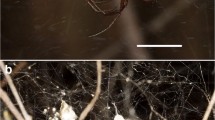Summary
In the natural habitat visited in this study, adult male red-backed salamanders (Plethodon cinereus) found near females were significantly larger than adult males found alone; there was no evidence for size assortative associations. Previous research has indicated that females associate preferentially with males that occupy high quality territories and that larger individuals are more successful at obtaining higher quality areas. In laboratory experiments, when resource quality was held constant and males were restrained so that male-male interactions were prohibited, females discriminated behaviorally between large and small males by spending more time visually and chemically assessing larger males and more time apparently attempting to leave the chamber when near smaller males. Females were found near the larger males at the end of the trials significantly more often than predicted by chance. In a separate experiment in which only females were restrained, larger males spent significantly more time in aggressive postures when paired with smaller males than when alone with the female. Smaller males spent significantly more time in submissive postures when paired with larger males and more time near the female when alone. Therefore, large body size of males may positively affect both intra- and intersexual interactions and, ultimately, mating success of male P. cinereus.
Similar content being viewed by others
References
Arnold SJ (1976) Sexual behavior, sexual interference and sexual defense in the salamanders Ambystoma maculatum, Ambystoma tigrinum and Plethodon jordani. Z Tierpsychol 42:247–300
Austad SN (1983) Game theoretical interpretation of male combat in the bowl and doily spider (Frontinella pyramitela). Anim Behav 31:59–73
Bateman AJ (1948) Intrasexual selection in Drosophila. Heredity 2:349–368
Bisazza A, Marconato A (1988) Female mate choice, male-male competition and parental care in the river bullhead, Cottus gobio L. (Pisces, Cottidae). Anim Behav 36:1352–1360
Bisazza A, Marconato A, Marin G (1989) Male competition and female choice in Padogobius martensi (Pisces, Gobiidae). Anim Behav 38:406–413
Côte IM, Hunter W (1989) Male and female mate choice in the redlip blenny: why bigger is better. Anim Behav 38:78–88
Darwin C (1871) The descent of man, and selection in relation to sex. John Murray, London
Davies NB, Halliday TR (1977) Optimal mate selection in the toad Bufo bufo. Nature 269:56–58
Dawley EM, Bass AH (1989) Chemical access to the vomeronasal organs of a plethodontid salamander. J Morphol 200:163–174
Doherty JA, Gerhardt HC (1984) Evolutionary and neurobiological implications of selective phonotaxis in the spring peeper (Hyla crucifer). Anim Behav 32:875–881
Gergits WF, Jaeger RG (1990) Field observations of the behavior of the red-backed salamander (Plethodon cinereus): courtship and agonistic interactions. J Herpetol 24:93–95
Horne EA (1988) Aggressive behavior of female red-backed salamanders. Herpetologica 44:203–209
Houck LD (1988) The effect of body size on male courtship success in a plethodontid salamander. Anim Behav 36:837–842
Houck LD, Arnold SJ, Thisted RA (1985) A statistical study of mate choice: sexual selection in a plethodontid salamander (Desmognathus ochrophaeus). Evolution 39:370–386
Jaeger RG (1979) Seasonal spatial distributions of the terrestrial salamander, Plethodon cinereus. Herpetologica 35:90–93
Jaeger RG (1984) Agonistic behavior of the red-backed salamander. Copeia 1984:309–314
Jaeger RG, Gergits WF (1979) Intra- and interspecific communication in salamanders through chemical signals on the substrate. Anim Behav 27:150–156
Jaeger RG, Joseph RG, Barnard DE (1981) Foraging tactics of a terrestrial salamander: sustained yield in territories. Anim Behav 29:1100–1105
Jaeger RG, Kalvarsky D, Shimizu N (1982) Territorial behaviour of the red-backed salamander: expulsion of intruders. Anim Behav 30:490–496
Lawrence WS (1986) Male choice and competition in Tetraopes tetraophthalmus: effects of local sex ratio variation. Behav Ecol Sociobiol 18:289–296
Mathis A (1989) Do seasonal spatial distributions in a terrestrial salamander reflect reproductive behavior or territoriality? Copeia 1989:788–791
Mathis A (1990a) Territoriality in a terrestrial salamander: the influence of body size and resource quality. Behaviour 112:162–175
Mathis A (1990b) Territorial salamanders assess sexual and competitive information via chemical signals. Anim Behav 44:953–962
Mathis A (1991) Territories of male and female terrestrial salamanders: costs, benefits, and intersexual spatial associations. Oecologia 86:433–440
Morris MR, Yoon SL (1989) A mechanism for female choice of large males in the treefrog Hyla chrysoscelis. Behav Ecol Sociobiol 25:65–71
Ovaska K (1987) Seasonal changes in agonistic behaviour of the western red-backed salamander, Plethodon vehiculum. Anim Behav 35:67–74
Severinghaus LL, Kurtak BH, Eickwort GC (1981) The reproductive behavior of Anthidium manicatum (Hymenoptera: Megachilidae) and the significance of size for territorial males. Behav Ecol Sociobiol 9:51–58
Siegel S (1956) Nonparametric statistics for the behavioral sciences. McGraw-Hill, New York
Simmons LW (1986) Female choice in the field cricket Gryllus bimaculatus (De Geer). Anim Behav 34:1463–1470
Trivers RL (1972) Parental investment and sexual selection. In: Campbell B (ed) Sexual selection and the descent of man. Aldine Press, Chicago, pp 136–179
Verrell PA (1984) Sexual interference and sexual defense in the smooth newt, Triturus vulgaris (Amphibia, Urodela, Salamandridae). Z Tierpsychol 66:242–254
Verrell PA (1989) The sexual strategies of natural populations of newts and salamanders. Herpetologica 45:265–282
Walls SC, Mathis A, Jaeger RG, Gergits WF (1989) Male salamanders with high quality diets have faeces attractive to females. Anim Behav 38:546–548
Woodward BD (1982) Sexual selection and nonrandom mating patterns in desert anurans (Bufo woodhousei, Scaphiopus couchi, Scaphiopus multiplicatus and Scaphiopus bombifrons).Copeia 1982:351–355
Author information
Authors and Affiliations
Rights and permissions
About this article
Cite this article
Mathis, A. Large male advantage for access to females: evidence of male-male competition and female discrimination in a territorial salamander. Behav Ecol Sociobiol 29, 133–138 (1991). https://doi.org/10.1007/BF00166488
Received:
Accepted:
Issue Date:
DOI: https://doi.org/10.1007/BF00166488




